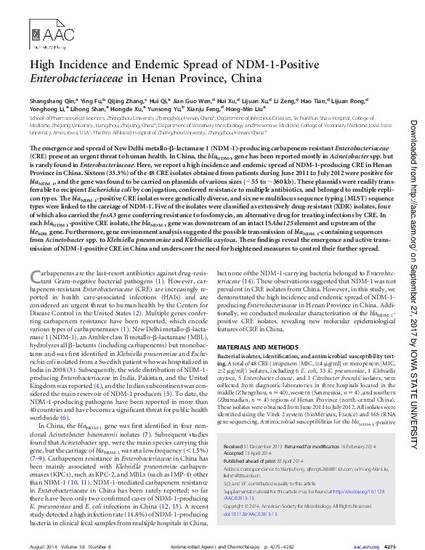
The emergence and spread of New Delhi metallo-β-lactamase 1 (NDM-1)-producing carbapenem-resistant Enterobacteriaceae (CRE) present an urgent threat to human health. In China, the blaNDM-1 gene has been reported mostly in Acinetobacter spp. but is rarely found in Enterobacteriaceae. Here, we report a high incidence and endemic spread of NDM-1-producing CRE in Henan Province in China. Sixteen (33.3%) of the 48 CRE isolates obtained from patients during June 2011 to July 2012 were positive for blaNDM-1, and the gene was found to be carried on plasmids of various sizes (∼55 to ∼360 kb). These plasmids were readily transferrable to recipient Escherichia coli by conjugation, conferred resistance to multiple antibiotics, and belonged to multiple replicon types. The blaNDM-1-positive CRE isolates were genetically diverse, and six new multilocus sequence typing (MLST) sequence types were linked to the carriage of NDM-1. Five of the isolates were classified as extensively drug-resistant (XDR) isolates, four of which also carried the fosA3 gene conferring resistance to fosfomycin, an alternative drug for treating infections by CRE. In each blaNDM-1-positive CRE isolate, the blaNDM-1 gene was downstream of an intact ISAba125 element and upstream of the bleMBL gene. Furthermore, gene environment analysis suggested the possible transmission of blaNDM-1-containing sequences from Acinetobacter spp. to Klebsiella pneumoniae and Klebsiella oxytoca. These findings reveal the emergence and active transmission of NDM-1-positive CRE in China and underscore the need for heightened measures to control their further spread.
Available at: http://works.bepress.com/qijing-zhang/41/

This article is published as Qin, Shangshang, Ying Fu, Qijing Zhang, Hui Qi, Jian Guo Wen, Hui Xu, Lijuan Xu et al. "High Incidence and Endemic Spread of NDM-1-Positive Enterobacteriaceae in Henan Province, China." Antimicrobial Agents and Chemotherapy 58, no. 8 (2014): 4275. doi: 10.1128/AAC.02813-13. Posted with permission.